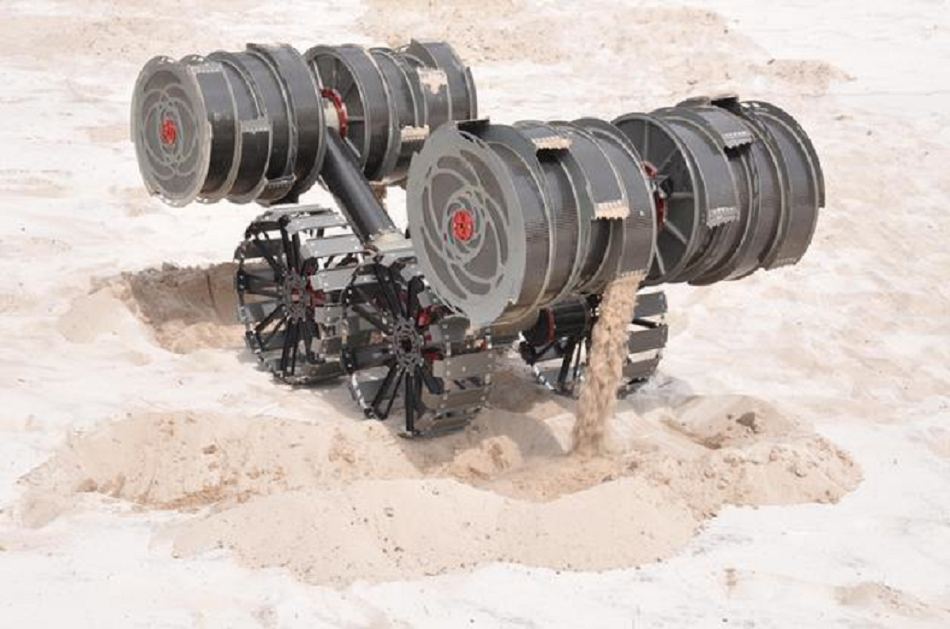
NASA RASSOR Image Credit: NASA
NASA is calling upon the extended scientific community to help design parts for their robotic platform RASSOR that will be used in missions on the moon.
NASA Opens Submissions to Bucket Drum Designs
Recently NASA announced that it is opening a competition calling upon participants to submit their designs for a bucket drum to be used in RASSOR, a lightweight lunar robot that will be used to dig on the moon’s surface. NASA is seeking a design that will provide the highest levels of regolith extraction and retention while at the same time remaining obstruction-free during the process of loading and unloading.
While NASA already has a solution to the numerous obstacles posed by excavation in reduced gravity, they are looking to improve on this, and for this reason, they are accepting designs from scientists around the world.
The scientist or team of scientists successful in having their design chosen by the space agency will receive a $3,000 cash reward. In total, $7,000 will be split between the top five submissions, with second place taking $2000, third taking $1000, and fourth and fifth being awarded $750 and $250 respectively.
Enhancing the Regolith Extraction Capabilities of RASSOR
RASSOR is a mobile robotic platform that is teleoperated. It is unique in its abilities in regolith excavation. The robot was designed with net-zero reaction force, which allows it to load, haul, and dump the excavated solid material in the challenging low gravity conditions on the moon.
Currently, the excavation and transporting of material in space is limited by its high expense, with it costing around $4,000 per pound to transport space material, and its tight launch vehicle shroud constraints. Therefore, RASSOR’s technology enables the launch of an efficient versatile robotic excavator on lunar missions at a reduced cost.
NASA’s scientists aim to improve on RASSOR’s design further by optimizing the design of its bucket drum, the part that collects and holds lunar soil, in order to enhance regolith extraction and retention levels.
RASSOR could also be used in other applications, such as terrestrial mining operations taking place in dangerous terrain, however, this would require a successful scale-up of its technology.
Ultimately, NASA intends to establish a long-term presence on the moon with the Artemis lunar exploration program, of which RASSOR will play a vital role.
Excavating in a Low-Gravity Environment
Currently, a number of versions of NASA’s moon-excavating robot have been tested by the space agency. Now, their focus is on improving the design of its bucket drum, the part which carries the excavated material.
The robotic system has opposing arms with counterrotating bucket drums, that produce near-zero horizontal net reaction force and minimal vertical net reaction force. This results in an excavation process that doesn't rely on the traction or weight of the mobility system to establish a reaction force to counteract the excavation force in the reduced-gravity atmosphere on the moon.
In the process of loading the bucket drums are used to excavate the material, such as soil and regolith using the scoops attached to the exterior of the drums that cut into the ground as they rotate at speeds of around 20 revolutions per minute. The excavated material then becomes trapped by baffles attached inside the hollow drums that also prevent the regolith from falling out of the drum once captured.
While hauling the load, rotating arms are used to raise the drums, clearing them above the excavation surface. Finally, the bucket drums reverse their rotation direction once they reach their dump location, resulting in the excavated material exiting the scoops.
The designs that NASA is hoping to receive will optimize this process, enhancing extraction and retention levels.
Submissions to the bucket drum design challenge are open until April 20th this year, with finalists being announced the following week, and winners announced on May 4th.
Disclaimer: The views expressed here are those of the author expressed in their private capacity and do not necessarily represent the views of AZoM.com Limited T/A AZoNetwork the owner and operator of this website. This disclaimer forms part of the Terms and conditions of use of this website.